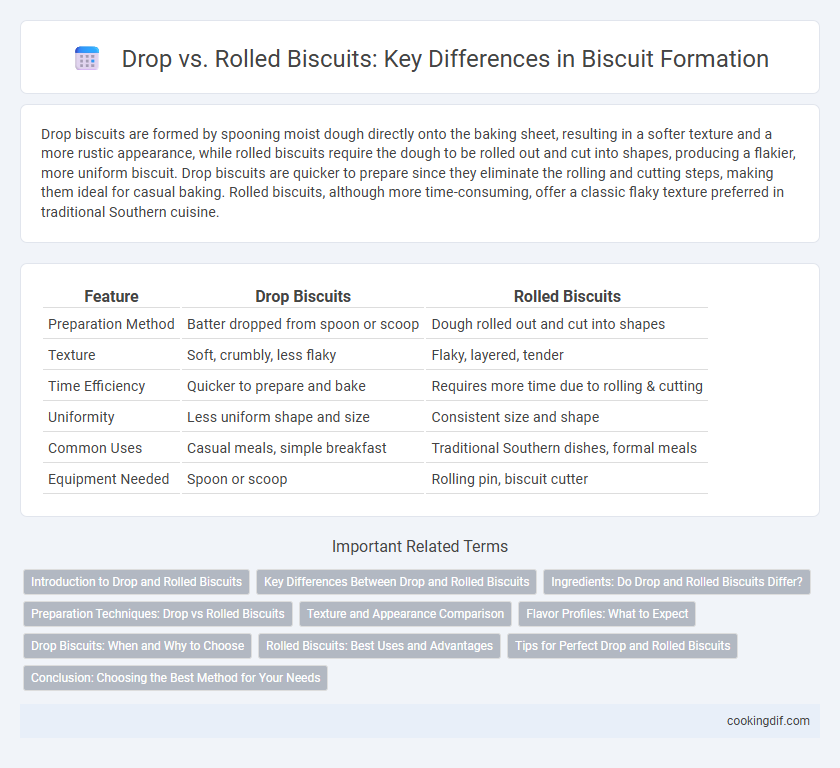Drop biscuits are formed by spooning moist dough directly onto the baking sheet, resulting in a softer texture and a more rustic appearance, while rolled biscuits require the dough to be rolled out and cut into shapes, producing a flakier, more uniform biscuit. Drop biscuits are quicker to prepare since they eliminate the rolling and cutting steps, making them ideal for casual baking. Rolled biscuits, although more time-consuming, offer a classic flaky texture preferred in traditional Southern cuisine.
Table of Comparison
| Feature | Drop Biscuits | Rolled Biscuits |
|---|---|---|
| Preparation Method | Batter dropped from spoon or scoop | Dough rolled out and cut into shapes |
| Texture | Soft, crumbly, less flaky | Flaky, layered, tender |
| Time Efficiency | Quicker to prepare and bake | Requires more time due to rolling & cutting |
| Uniformity | Less uniform shape and size | Consistent size and shape |
| Common Uses | Casual meals, simple breakfast | Traditional Southern dishes, formal meals |
| Equipment Needed | Spoon or scoop | Rolling pin, biscuit cutter |
Introduction to Drop and Rolled Biscuits
Drop biscuits feature a wetter dough dropped by spoonfuls onto baking sheets, producing a soft, crumbly texture ideal for quick preparation. Rolled biscuits involve a firmer dough that is rolled out and cut into shapes, resulting in a flakier, layered consistency preferred for traditional biscuit shapes. Both methods influence biscuit density, crumb structure, and baking time, catering to different taste and texture preferences.
Key Differences Between Drop and Rolled Biscuits
Drop biscuits are made by dropping spoonfuls of dough onto a baking sheet, resulting in a softer, more irregular shape with a tender crumb. Rolled biscuits involve rolling out the dough and cutting it into uniform shapes, creating a flaky texture and a more structured appearance. The main differences lie in texture, shape consistency, and preparation method, with drop biscuits offering ease and speed, while rolled biscuits provide a classic flaky bite.
Ingredients: Do Drop and Rolled Biscuits Differ?
Drop and rolled biscuits primarily differ in dough consistency and handling rather than ingredient composition; both typically use flour, baking powder, salt, butter or shortening, and milk or buttermilk. Drop biscuits have a wetter dough with higher liquid content, making them easier to drop onto the baking sheet without shaping, while rolled biscuits require a stiffer dough for rolling and cutting. The ingredient ratios in rolled biscuits often lean towards less liquid and more flour to achieve the firmer texture necessary for rolling and forming.
Preparation Techniques: Drop vs Rolled Biscuits
Drop biscuits require a wetter dough that is spooned directly onto the baking sheet, producing a soft, crumbly texture with a rustic shape ideal for quick preparation. Rolled biscuits involve a stiffer dough that is rolled out and cut into uniform shapes, yielding a flakier, layered crumb due to even thickness and consistent oven heat exposure. The choice between drop and rolled biscuits influences the final texture, appearance, and baking time, with rolled biscuits generally requiring more precise handling and longer preparation.
Texture and Appearance Comparison
Drop biscuits have a rough, crumbly texture due to higher moisture content and less kneading, resulting in a rustic, uneven appearance. Rolled biscuits offer a denser, flakier texture with a smooth, uniform shape achieved through precise rolling and cutting techniques. Texture differences arise from mixing and handling methods, influencing the final biscuit's tenderness and visual appeal.
Flavor Profiles: What to Expect
Drop biscuits, made from a looser dough, tend to have a tender, crumbly texture with a buttery, slightly sweet flavor that absorbs spices and herbs well. Rolled biscuits feature a firmer dough that creates a flaky, layered bite and a rich, buttery taste with a subtle toastiness from the surface browning. Expect drop biscuits to deliver a softer, melt-in-your-mouth flavor experience, while rolled biscuits offer a more structured texture and pronounced golden crust flavor.
Drop Biscuits: When and Why to Choose
Drop biscuits are preferred for quick preparation since their batter-like consistency allows easy spooning onto baking sheets without kneading. They produce soft, fluffy interiors with a slightly irregular shape, ideal for casual meals or when time is limited. Opt for drop biscuits when you need a reliable, fast option that requires minimal handling but still delivers tender results.
Rolled Biscuits: Best Uses and Advantages
Rolled biscuits offer a tender, flaky texture ideal for breakfast dishes and savory pairings due to their uniform thickness and controlled layering. This method allows for better gluten development, resulting in a consistent rise and a golden, crisp exterior that enhances both presentation and flavor. Homemade and bakery-made rolled biscuits benefit from this technique to achieve a delicate crumb that complements gravies, soups, and spreads.
Tips for Perfect Drop and Rolled Biscuits
Achieving perfect drop biscuits requires using cold butter and minimal mixing to maintain a tender, flaky texture, while spooning the batter directly onto the baking sheet ensures their signature irregular shape. For rolled biscuits, chilling the dough before rolling and using light, even pressure with a floured cutter helps create uniform thickness and well-defined edges. Both techniques benefit from baking on a preheated oven surface to promote proper rising and golden crust development.
Conclusion: Choosing the Best Method for Your Needs
Drop biscuits offer a quick, rustic texture ideal for casual meals, while rolled biscuits provide a flaky, uniform crumb perfect for more refined presentations. Consider drop biscuits for simplicity and speed, and rolled biscuits when appearance and layered consistency matter most. Your choice depends on the desired texture, time constraints, and presentation style for your biscuit-making needs.
Drop vs Rolled for biscuit formation Infographic

 cookingdif.com
cookingdif.com